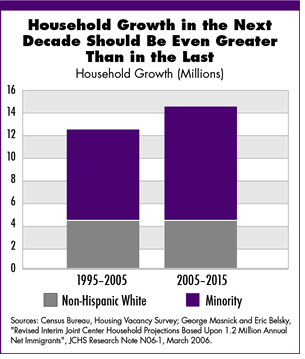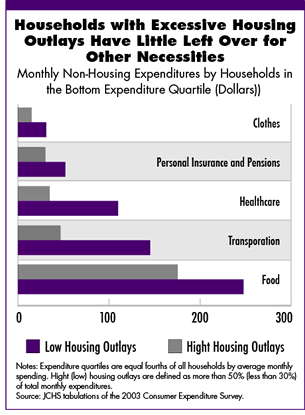

7/2006
Years of high house-price appreciation and rising mortgage rates have created serious affordability problems in many areas


by Kermit Baker, PhD, Hon. AIA
Chief Economist
The 10-year housing boom came under growing pressure in 2005. With interest rates rising, builders in many states responded to slower sales and larger inventories by scaling back on production. Meanwhile, higher energy costs hit household budgets just as climbing interest rates crimped the spending of homeowners with adjustable mortgages.
Nevertheless, the housing sector continues to benefit from solid job and household growth, recovering rental markets, and strong home price appreciation. As long as these positive forces remain in place, the current slowdown should be moderate.
Over the longer term, household growth is expected to accelerate from about 12.6 million over the past 10 years to 14.6 million over the next 10 years. When combined with projected income gains and a rising tide of wealth, strengthening demand should lift housing production and investment to new highs. But with the economy generating so many low-wage jobs and land use restrictions driving up housing costs, today’s widespread affordability problems will intensify.
These are some of the key findings from the recently released State of the Nation’s Housing 2006 from the Joint Center for Housing Studies of Harvard University.
Stretching to buy homes
Although monthly mortgage costs to buy a median-priced home with a fixed-rate loan have risen only in the past two years, affordability in the nation’s hottest housing markets has been eroding for some time. Unlike in metropolitan areas with more moderate appreciation, the interest rate declines in 2000–2003 did not offset the impact of skyrocketing prices in these markets. Affordability pressures are now spreading, with median house prices in a growing number of large metros exceeding median household incomes by four or more times.
Even so, homebuyers scrambled to get in on still-hot markets last year. In stretching to afford ever more expensive homes, homebuyers increasingly turned to mortgage products other than fixed rate loans to lower their monthly payments at least initially. The most popular of these loans was the standard adjustable-rate mortgage, followed by interest-only loans, with payment-option loans a distant third.
In just the past two years, interest-only loans (which defer principal payments for a set number of years) have gone from relative obscurity to an estimated 20 percent of the dollar value of all loans and 37 percent of adjustable-rate loans originated in 2005. Payment-option loans, which let borrowers make minimum payments that are even lower than the interest due on the loan and roll the balance into the amount owed, also accounted for nearly 10 percent of last year’s loan originations, but a much smaller share of outstanding loans. While these products helped to shore up housing markets last year by blunting the impacts of rising interest rates and home prices, proposed federal guidelines may limit their growth.
Although borrowers with interest-only loans will see their housing outlays jump when their principal payments come due, these increases are still some years off. Borrowers thus have time for their incomes to catch up, rates to fall, or either refinance or move.
Sizeable equity stakes protect most homeowners from selling at a loss even if they cannot keep up with their payments because they lose their jobs or for other reasons. As last measured in 2004—even before the latest spurt in home values—only 3 percent of homeowners had equity cushions of less than 5 percent and fully 86 percent had cushions of at least 20 percent.
 Strong demand fundamentals
Strong demand fundamentals
Despite the current cool-down, the long-term outlook for housing is bright. New projections—reflecting more realistic, although arguably still conservative, estimates about future immigration—put household growth in the next decade fully 2.0 million above the 12.6 million of the past decade. On the strength of this growth alone, housing production should set new records.
With each generation exceeding the income and wealth of its predecessor, growth in expenditures on home building and remodeling should match if not surpass the current pace. For example, the median inflation-adjusted income of households in their 40s was $1,824 higher in 2005 than in 1995, while that of households in their 50s was $1,869 higher. Similarly, between 1995 and 2004, the median wealth of those in their 40s was up by $33,585 and of those in their 50s by $46,633. But incomes at the top are increasing much faster than those at the bottom—and even those in the middle. These differences will likely drive rapid growth in the burgeoning luxury sector of the housing market while presenting stubborn affordability challenges for households with low and moderate incomes.
As the members of the baby-boom generation reach their 50s and 60s with record wealth, they will boost the market for senior housing and second homes. At the other end of the age spectrum, the baby boomers’ children, together with same-age immigrants and second-generation Americans, will buoy demand for starter homes and apartments. As this large generation moves into adulthood, the demographics will turn slightly more favorable for rental than for-sale housing.
Meanwhile, foreign-born and minority households will continue to be the fastest-growing segments of the housing market. Thanks to strong immigration and slightly higher rates of natural increase, the minority share of households should expand from 28 percent in 2005 to 32.5 percent in 2015.
Foreign-born individuals already represent 13 percent of the U.S. population, including 18 percent of young adults aged 20 to 29. Immigrants have added especially to the ranks of the baby-bust and echo baby-boom generations, bringing new life to center cities that once experienced population declines. Immigrants thus represent not only a key source of labor for the housing industry, but also a large and growing customer base.
Long-term housing challenges
While the vast majority of Americans still pay a manageable share of their income for housing, affordability problems are worsening. In just the three years from 2001 to 2004, the number of households paying more than half their incomes for housing shot up by 1.9 million. This increase brought the number of low- and middle-income households with severe cost burdens to 15.6 million.
 Working in no way protects families from the hardship of excessive housing outlays. In fact, 49 percent of poor working families with children (working more than half time but earning less than the poverty level) had severe cost burdens in 2004 and 75 percent had at least moderate burdens. Among near-poor working families with children (with incomes of one to two times the poverty level), the share with severe burdens was 17 percent and with at least moderate burdens 52 percent.
Working in no way protects families from the hardship of excessive housing outlays. In fact, 49 percent of poor working families with children (working more than half time but earning less than the poverty level) had severe cost burdens in 2004 and 75 percent had at least moderate burdens. Among near-poor working families with children (with incomes of one to two times the poverty level), the share with severe burdens was 17 percent and with at least moderate burdens 52 percent.
As households spend excessive shares of their incomes on housing, they have little left over for other basic needs (Figure 2). Accordingly, many choose to trade off longer commutes for more affordable housing. As evidence, households in every expenditure quartile without high housing outlays spent much more on transportation than those with high housing outlays. Among those in the bottom expenditure quartile, for example, the difference in travel costs between the two groups was $99 per month.
Government’s role
With so many Americans struggling to afford housing, the federal government has stepped up by subsidizing about a quarter of renter households with household incomes of less than half of area medians. These subsidies typically hold tenant rent contributions to 30 percent of household income. In addition, states are authorized to issue tax-exempt bonds and housing tax credits, which have already financed nearly two million low-income rental units, as well as assisted more than two million first-time homebuyers over the past 15 years. State and local governments also allocate federal block grants, along with housing trust funds, to assist in creating affordable housing and broaden opportunities for low-income homeownership.
At the local level, however, land use regulations often make it difficult for builders to develop affordable housing. Large minimum lot sizes, restrictions on the land available for residential development, impact fees that place the marginal cost of infrastructure and public services on new homebuyers, and permitting and approval processes that add risk and delay all play a hand in raising housing prices. Because per-unit impact fees and permitting costs represent such a large share of the development costs for more modest units, they especially discourage low-income housing production.
Although many of these regulations are intended to address important public policy concerns such as environmental protection and public health, they nevertheless make housing more expensive. Indeed, the stricter the development regulations, the more intense the affordability problems—especially for middle-income households.
But relaxing development regulations alone will not eliminate housing affordability problems. It is now impossible to build housing at prices anywhere near what low-income households can afford without deep subsidy because the cost of owning and operating even modest housing puts it out of reach for many with low-income budgets. As a result, affordable rental housing is disappearing at an alarming rate. For example, the supply of housing affordable to those earning $16,000 or less shrank by 13 percent between 1993 and 2003, falling short of need by some 5.4 million units.
Copyright 2006 The American Institute of Architects.
All rights reserved. Home Page ![]()
![]()
In addition to his role as chief economist for the AIA, Kermit Baker also serves as a senior research fellow and is the project director of the Remodeling Futures Program for the Joint Center for Housing Studies of Harvard University.
Copies of the State of the Nation’s Housing 2006 are available at no cost from the Joint Center’s Web site. Printed copies may be purchased for $15 by calling 617-495-7908.
![]()